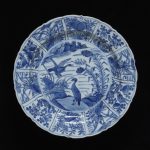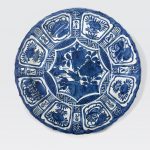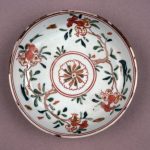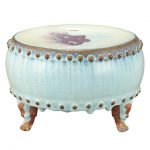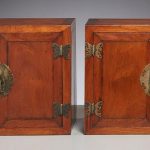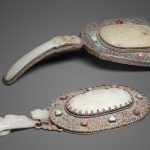The Ming dynasty, officially the Great Ming, was the ruling dynasty of China from 1368 to 1644 following the collapse of the Mongol-led Yuan dynasty. The Ming dynasty was the last imperial dynasty of China ruled by Han Chinese. Although the primary capital of Beijing fell in 1644 to a rebellion led by Li Zicheng (who established the Shun dynasty, soon replaced by the Manchu-led Qing dynasty), numerous rump regimes loyal to the Ming throne – collectively called the Southern Ming – survived until 1662. Reference: Wikipedia.
Below are some examples, information and price guides to antique Ming items which feature butterflies in their design, including a blue and white Kraak dish and a Junyao stand.
This dish is an example of a mass-produced Chinese porcelain carried to Europe in Dutch ships in the late 16th/early 17th century. Porcelains made for the European market are of a different quality to those made for the Chinese court. The painted decoration is usually very sketchy, the stock of designs fairly limited. The most common decorative pattern is that of panels enclosing plants or animals, as on this dish.
Flat rim, lobed edge, the front painted on the centre with two water-fowls by a pond, one flying and one standing on the shore. Eight panels around the rim, each panel enclosing a floral design which is so sketchily drawn that, apart from the lotus, it is not possible to identify what species they are meant to represent. Within three of the panels a bird, a frog and a moth have been added, all sketchily drawn. The back of the dish is painted with eight wider panels alternating with narrower panels, the wider panels enclosing a lingzhi (magic fungus) or a butterfly.
This dish is an example of a mass-produced Chinese porcelain carried to Europe in Dutch ships in the late 16th/early 17th century. By that time Chinese porcelain had become more affordable to European consumers thanks to improved shipping. Orders from Dutch and Protuguese traders happened to arrive at Jingdezhen, the porcelain city in southern China, at a time when patronage from the Chinese court was in drastic decline. Porcelains made for the European market are of a different quality to those made for the Chinese court. The former shows a number of characteristics that make it possible for ceramic historians to study them as a distinct category, under the rubric of ‘Kraak porcelain’. The painted decoration is usually very sketchy, the stock of designs fairly limited. The most common decorative pattern is that of panels enclosing plants or animals. The arrangements of the panels changed with times, enabling ceramic historians to work out a chronology of the production dates of Kraak porcelain. The pattern on the present dish falls within the ‘Border IV’ group, which is defined as ‘equal-sized panels filled with delicate flowers, insects or birds’. An egret is painted on the base of the dish. Ceramic historians are still unable to come up with a satisfactory explanation for this peculiar symbol. It is not the symbol of a particular kiln, because the wares carrying this symbol are of varying qualities, ranging from coarse to the very fine. Although Kraak porcelain must have generated much income for China, Chinese records about its production and export hardly exist today. Scholars rely on records of the various East India companies in Europe. Cargoes from several shipwrecks discovered in the 20th century provide additional information about a commodity that had once played an important role in Sino-European trade.
Reference: © Victoria and Albert Museum
A blue and white Kraak porcelain deep dish Late Ming dynasty Thinly molded with a fluted edge to the canted rim and painted with opposing reserves of flowers and auspicious emblems that surround a central roundel of a butterfly, flowers and garden rock, the reverse also painted with alternating reserves (chips and glaze frits to rim, foot chipped). 12 3/8in (31.4cm) diameter
Sold for US$ 1,062 (£ 823) inc. premium at Bonham’s in 2017
Porcelain dish. Decorated in overglaze green, yellow, red and brown enamels. Flowerhead in the centre, enclosed by two pomegranate branches with birds and butterfly around walls. Outside undecorated. There is a mark on the base.
Reference: © The Trustees of the British Museum
A LATE MING WUCAI SAUCER-DISH WANLI SIX-CHARACTER MARK WITHIN A DOUBLE CIRCLE AND OF THE PERIOD (1573-1619) With shallow rounded sides, the centre of the interior painted and enamelled with the figure of Zhong Kui with raised sword chasing a snake below an overhead branch, the well with scattered flowers, fungus and butterflies, the reverse similarly decorated around the sides with an additional lizard. 5½ in. (14 cm.) diam.
Sold for GBP 10,755 at Christies in 2003
Chinese Junyao Stand Ming Dynasty Of drum shape, raised on three animal mask and pad legs, the sides with two rows of raised knops, covered overall in a light blue glaze with central purple splash suggesting a butterfly. Diameter 9 inches.
Sold for $6,250 (includes buyer’s premium) at Doyle in 2012
Good pair Chinese Huanghuali cabinets, Likely Ming Dynasty, pair small double door cabinets with butterfly form hinge hardware and lock plates, 15″h x 20.25″w x 12″d
Sold for $13,000 at Millea Bros Ltd in

